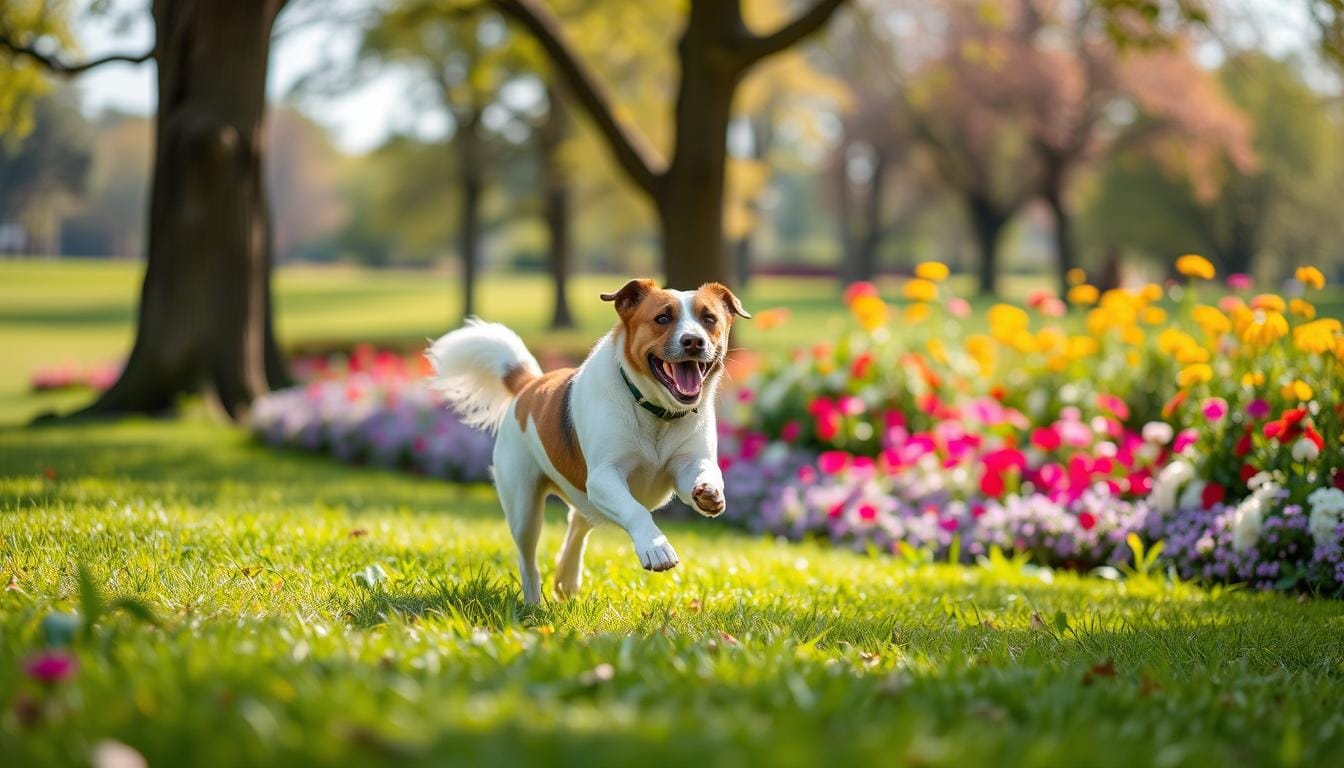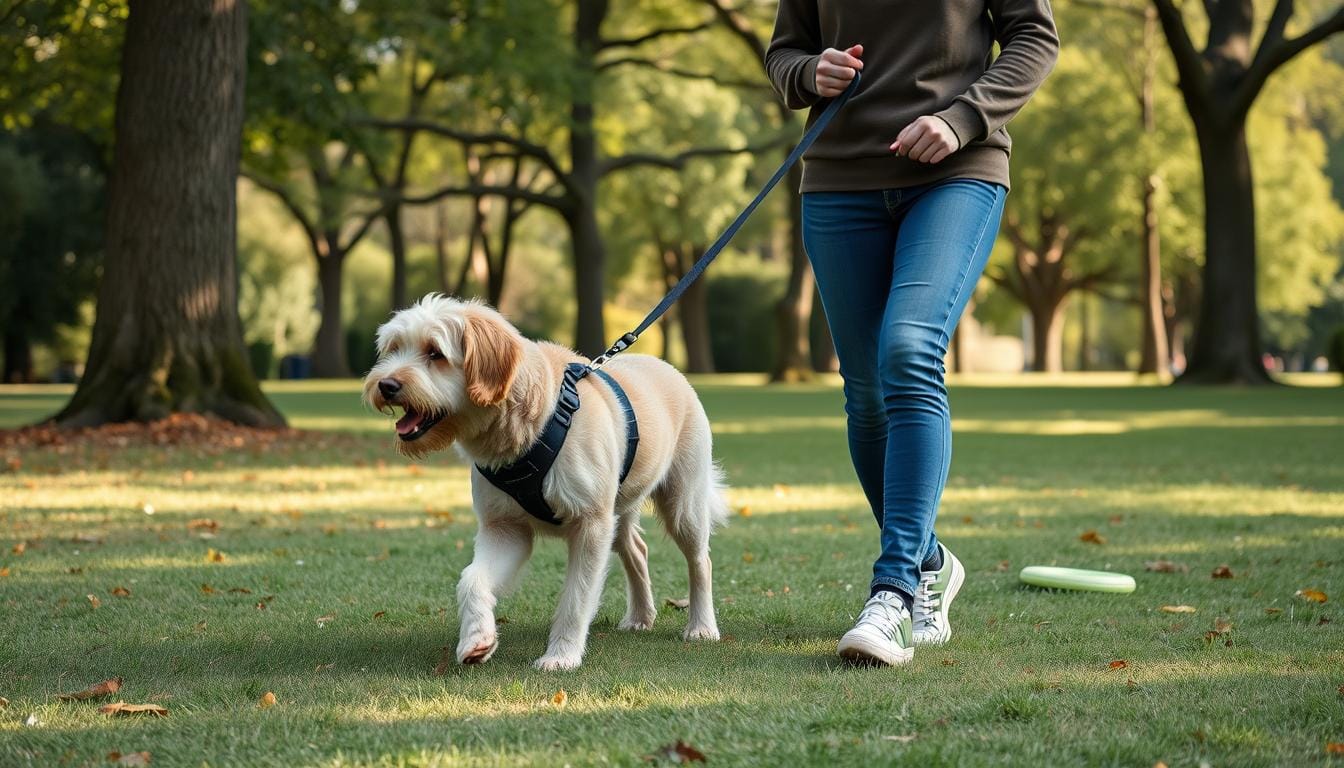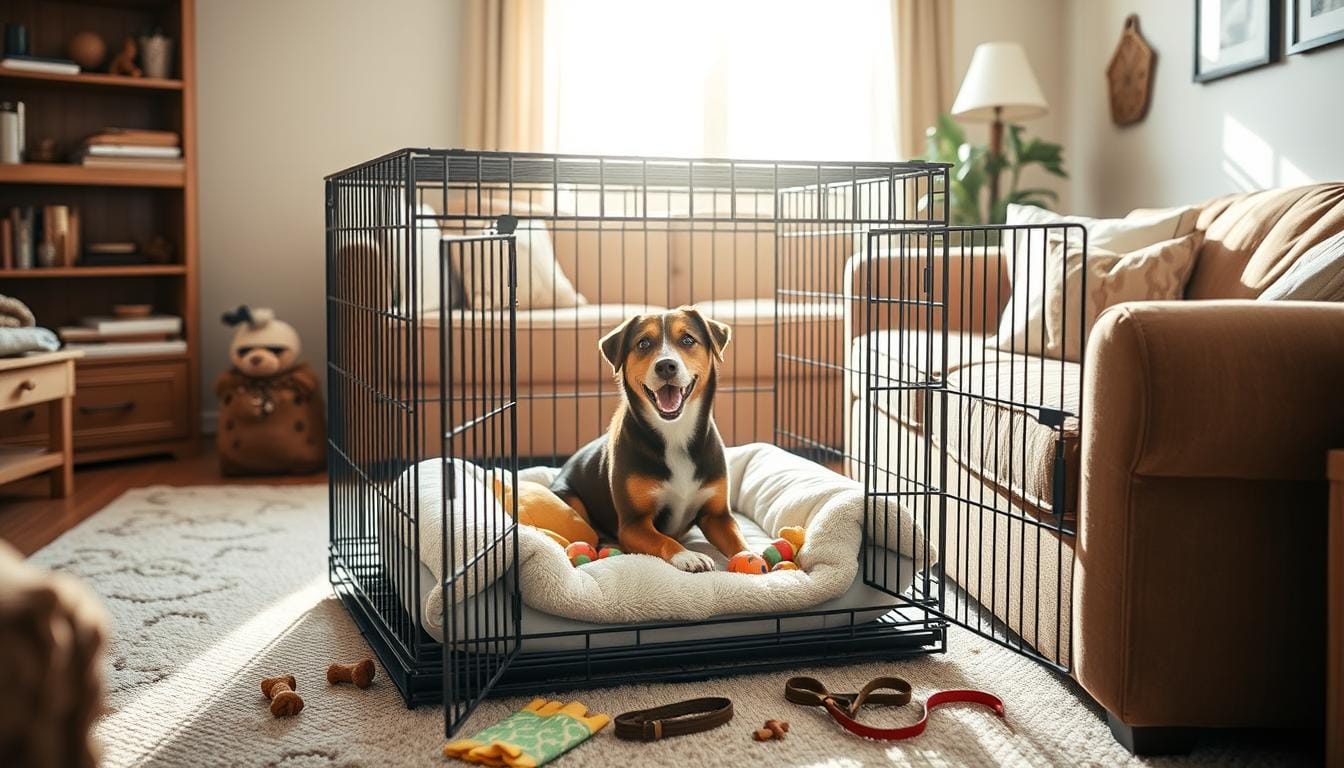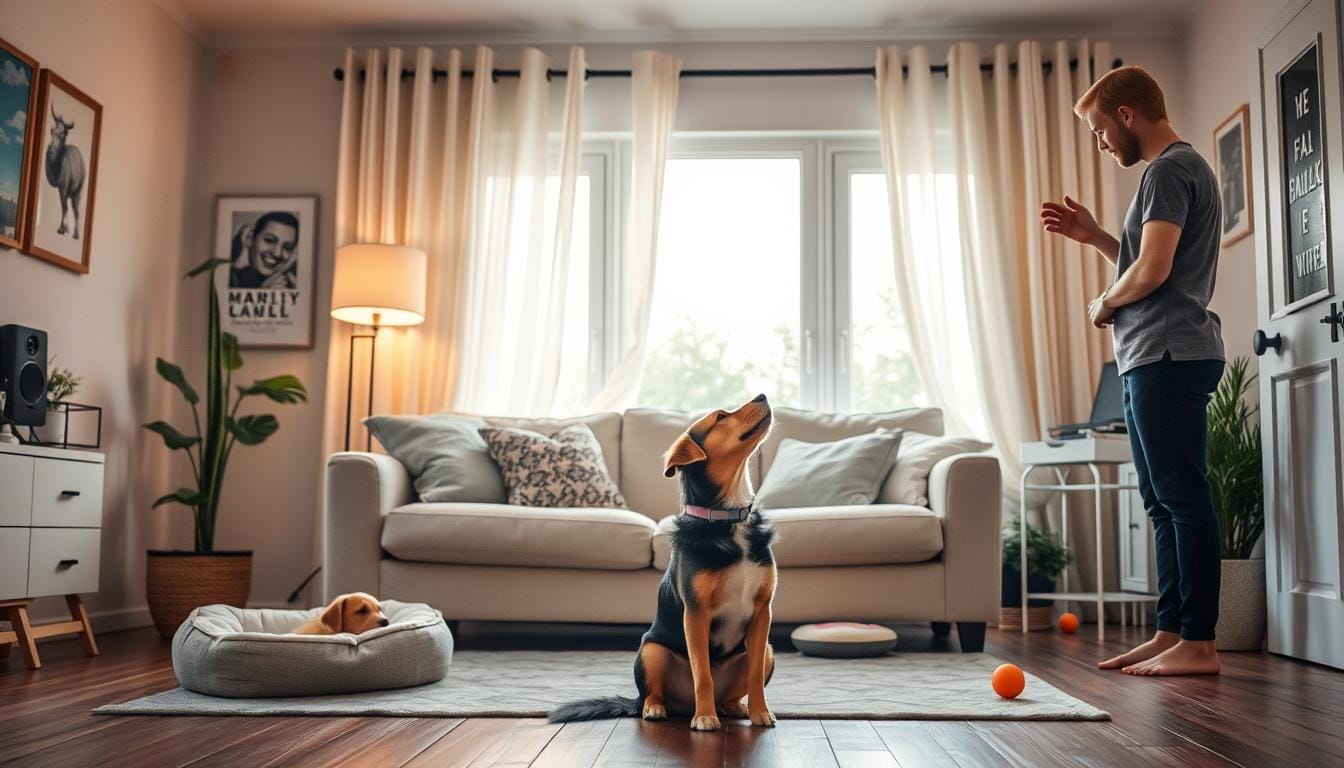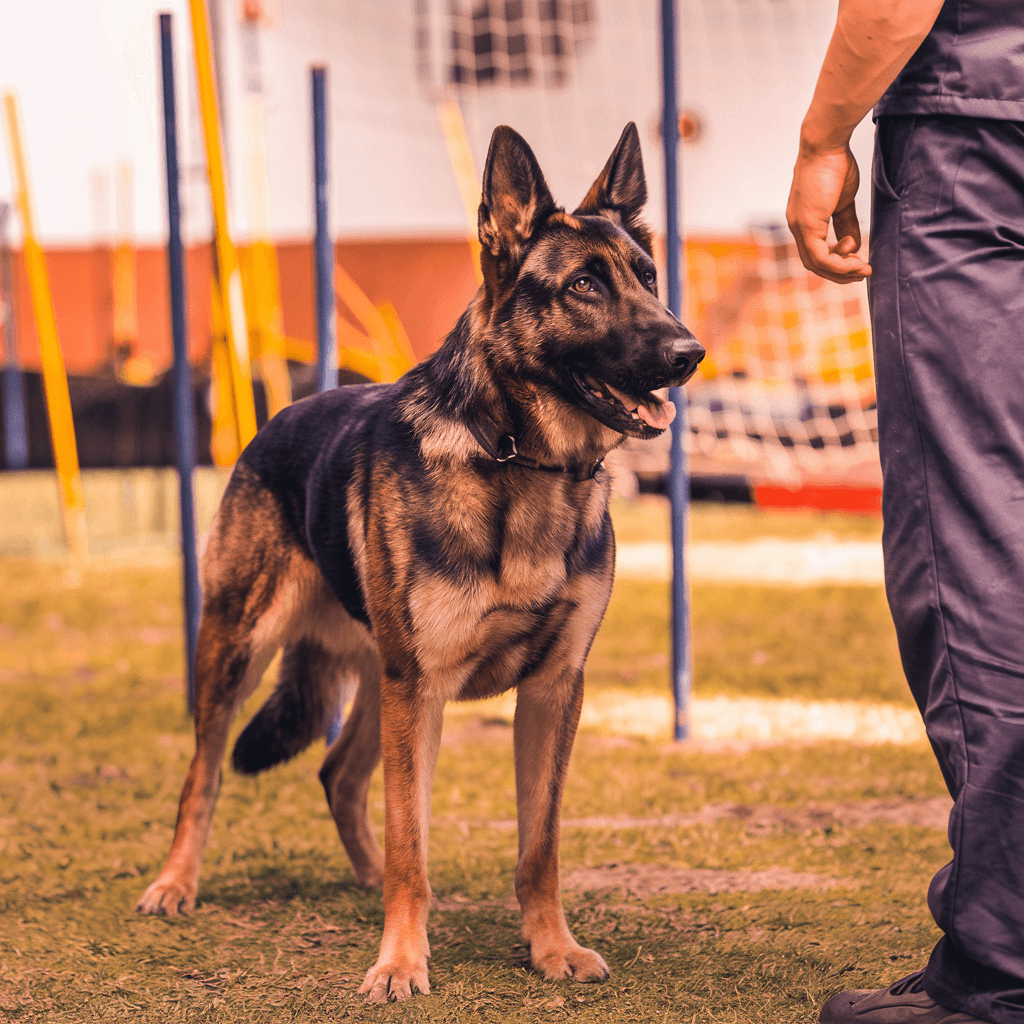We all want our furry friends to be happy and healthy. Dog exercise is key to this goal. Active dogs are not just happier; they’re also healthier.
Did you know obesity is a big health issue for dogs? Regular exercise can prevent this. Vets say adult dogs need 30 minutes to 2 hours of activity daily. This depends on their age, breed, and health.
Puppies love short walks and playtime. As dogs get older, their exercise needs change. Arthritic dogs do well with gentle walks to keep their joints moving.
Off-leash walks are great for dogs to explore and stay active. Exercise is not just for physical health. It’s also vital for mental well-being.
Key Takeaways
- Exercise prevents obesity in dogs
- Adult dogs need 30 minutes to 2 hours of daily activity
- Puppies require short walks and play sessions
- Off-leash walks offer mental and physical benefits
- Exercise helps manage behavioral issues
- Regular activity is crucial for dogs’ mental well-being
- Adjust exercise routines based on age and health status
Understanding the Basic Needs for Canine Exercise
Dogs need regular physical activity to stay healthy and happy. The amount of exercise they need depends on their breed, age, and energy level. Let’s look at the key parts of exercise for dogs to keep them fit and joyful.
Physical Activity Requirements for Different Dog Breeds
Some dog breeds, like Border Collies and Siberian Huskies, need more exercise than others. For example, Pugs and Chihuahuas need less. It’s important to pick a dog that fits your lifestyle and energy level. High-energy breeds might need up to two hours of exercise each day, while others are happy with just 30 minutes.
| Breed Type | Daily Exercise Needs | Recommended Activities |
|---|---|---|
| High-energy | 1-2 hours | Dog running, hiking, agility training |
| Medium-energy | 30-60 minutes | Dog walking, fetch, swimming |
| Low-energy | 30 minutes | Short walks, indoor play |
The Role of Exercise in Natural Dog Behavior
Exercise is key to meeting a dog’s natural instincts. It helps prevent bad behavior, reduces restlessness, and boosts their mental health. Activities like dog walking or playing fetch let dogs explore and use their energy in a good way.
Daily Exercise Requirements by Age and Size
Exercise needs change as dogs grow. Puppies under 16 weeks need short, frequent play. Adult dogs should get at least 30 minutes of exercise each day. Seniors do best with low-impact activities. Adjust your dog’s exercise to their age, size, and energy to keep them healthy and prevent obesity.
- Puppies: Multiple short play sessions daily
- Adult dogs: 30 minutes to 2 hours of exercise per day
- Senior dogs: 30 minutes of low-impact exercise, divided into 2-3 sessions
By understanding and meeting your dog’s exercise needs, you’ll help their physical and mental health. This makes for a happy and healthy companion.
Health Benefits of Regular Exercise for Dogs
Regular physical activity is key for dog health. It offers many benefits beyond just keeping them fit. Let’s look at the main advantages of keeping your dog active.
Cardiovascular Health Improvements
Exercise makes your dog’s heart and lungs stronger. A daily walk or playtime can lower blood pressure and improve circulation. This boosts organ function and keeps your dog energetic, reducing heart problems.
Muscle Development and Bone Strength
Physical activity is vital for strong muscles and bones in dogs. It helps:
- Improve muscle tone
- Reduce the risk of injuries
- Promote healthy bone density
- Enhance overall dexterity and mobility
Dogs without exercise are more likely to have weak muscles, bone disorders, and injuries.
Weight Management and Obesity Prevention
Regular exercise is key to preventing dog obesity. It helps manage weight by:
- Burning excess calories
- Boosting metabolism
- Maintaining a healthy appetite
Obesity in dogs can cause respiratory problems, joint pain, and diabetes. Keeping your dog active helps prevent these issues.

| Exercise Type | Benefits | Frequency |
|---|---|---|
| Walking | Improves cardiovascular health, aids digestion | Daily |
| Running | Builds muscle, burns calories | 2-3 times per week |
| Agility Training | Enhances coordination, mental stimulation | 1-2 times per week |
| Swimming | Low-impact exercise, great for joints | 1-2 times per week |
By mixing different exercises into your dog’s routine, they get many health benefits. Make sure to adjust the activities to your dog’s breed, age, and needs for the best results.
Mental Health Benefits of Physical Activity
Physical activity is key for dog mental health and overall well-being. Active dogs get many cognitive benefits. These benefits make them happier and improve their quality of life.
Studies show that exercise boosts brain health in mammals. It releases brain-derived neurotrophic factor (BDNF). This helps grow new brain cells, improving learning and memory in dogs.
A study with over 15,000 dogs found a big difference. Inactive dogs were 6.5 times more likely to get canine cognitive dysfunction. This shows how important exercise is for their brain health.
“Exercise can immediately improve mood,” says Breer Gordon, Ph.D., an exercise psychology researcher at Penn State College of Medicine.
Just like humans, dogs get mental health benefits from exercise. Gregory Berns, a neuroscientist at Emory University, found dogs feel emotions like us. They get the same mental health benefits from physical activity.
| Chemical | Role in Mental Health |
|---|---|
| Endorphins | Natural mood elevators |
| Norepinephrine | Improves alertness and focus |
| Dopamine | Enhances pleasure and reward sensations |
| Serotonin | Regulates mood and social behavior |
The American Kennel Club says regular exercise can slow down age-related brain decline. By keeping our dogs active, we help them stay mentally sharp as they age.
Preventing Behavioral Problems Through Exercise
Regular dog exercise is key to keeping active dogs healthy. It not only keeps them fit but also stops many behavioral problems.
Reducing Destructive Behaviors
Dogs with too much energy often act out. Daily exercise routines help a lot. A tired dog is less likely to chew furniture or dig up the yard.
Managing Excess Energy
Different breeds need different amounts of exercise. High-energy dogs like Border Collies and Australian Shepherds need lots of activity. Brachycephalic breeds do better with moderate activities. It’s important to match exercise to your dog’s energy level.

Improving Social Skills
Exercise helps dogs meet other animals and people. Regular trips to dog parks or group walks make them more social.
| Breed Type | Exercise Needs | Recommended Activities |
|---|---|---|
| High-Energy (e.g., Border Collies) | 2+ hours daily | Running, agility training |
| Moderate-Energy (e.g., Retrievers) | 1-2 hours daily | Walking, swimming |
| Low-Energy (e.g., Bulldogs) | 30-60 minutes daily | Short walks, gentle play |
Adding regular exercise to our dogs’ lives improves their health and stops many behavioral problems. This makes them happier and better-adjusted pets.
Popular Exercise Options for Dogs
Dogs need daily exercise to stay healthy and happy. We’ll explore some great ways to keep your furry friend active and engaged. From simple walks to exciting agility courses, there’s an exercise option for every dog.
Walking and Running Routines
Dog walking is a classic exercise that suits most breeds. Start with short walks for puppies, about 5 minutes per month of age, twice daily. Adult dogs often enjoy longer strolls or runs. High-energy breeds like border collies thrive on more intense activities, while bulldogs prefer gentler sessions.
Interactive Play and Games
Playtime isn’t just fun – it’s great exercise! Fetch, tug-of-war, and hide-and-seek are perfect for mental and physical stimulation. These games strengthen your bond and keep your dog’s mind sharp. For water-loving pups, swimming offers a full-body workout that’s easy on the joints.
Agility Training Activities
Dog agility training combines exercise with skill-building. Set up an obstacle course in your backyard or join a local club. This activity improves coordination, builds confidence, and burns energy. It’s ideal for smart, active breeds but can be adapted for all dogs.
| Exercise Type | Benefits | Suitable For |
|---|---|---|
| Dog Walking | Physical fitness, mental stimulation | All breeds, ages |
| Dog Running | Cardiovascular health, energy release | High-energy breeds, adult dogs |
| Dog Hiking | Endurance, sensory stimulation | Active breeds, adventurous dogs |
| Dog Agility Training | Coordination, mental challenge | Smart, energetic breeds |
Remember, every dog is unique. Consult your vet to create an exercise plan that suits your pet’s age, breed, and health condition. With the right mix of activities, you’ll keep your dog fit, happy, and thriving.
Creating a Structured Exercise Routine
A good dog exercise plan is essential for active dogs. Start with small steps and gradually add more activity. For instance, adding 10-15 minutes to daily walks can significantly improve their health.
It’s important to know your dog’s limits during walks. This helps you find the perfect exercise time for them.
Physical activity needs change based on breed, age, and personality. Puppies do well with short, fun activities. Working breeds need more exercise every day. Senior dogs prefer less intense activities.
The AKC FIT DOG program is a great way to structure your dog’s fitness. To get a FIT DOG magnet, walk your dog for 15 minutes, ten times a week, for three months. Or, you can walk them for 30 minutes, five times a week, for three months.
| AKC FIT DOG Title | Requirements |
|---|---|
| Bronze | 15-minute walks, 10 times/week, 3 months |
| Silver | 30-minute walks, 5 times/week, 3 months |
| Gold | Advanced activities, longer duration |
This program is for healthy adult dogs and runs until December 31, 2024. It’s not for dogs with joint problems or seniors with health issues. Always talk to your vet before starting a new exercise plan.
Exercise Safety and Precautions
Keeping our furry friends healthy through physical activity is crucial, but we must prioritize their safety. Let’s explore important precautions to ensure our dogs stay safe during exercise.
Weather Considerations
Weather plays a significant role in dog health during outdoor activities. Hot days can lead to overheating, while cold weather might cause discomfort. We should adjust our exercise routines based on temperature and humidity to keep our active dog breeds safe.
Signs of Overexertion
Recognizing when our dogs have had enough is vital. Watch for these warning signs during physical activity:
- Excessive panting
- Tongue hanging out far
- Pale or bright red gums
- Vomiting or diarrhea
- Lagging behind or reluctance to continue
- Post-workout soreness
Exercise Limitations by Breed
Different breeds have unique exercise needs. For instance, flat-faced dogs like pugs should avoid jogging due to breathing difficulties. It’s best to wait until a dog is at least one year old before starting intense activities like running, allowing their joints to develop fully.
| Dog Type | Exercise Recommendations |
|---|---|
| Overweight dogs | Avoid jogging, focus on low-impact activities |
| Puppies | Short, gentle play sessions; avoid long runs |
| Senior dogs | Regular, moderate walks; swimming for joint health |
| Active breeds | Intense activities like agility training or long hikes |
Remember, consulting a veterinarian is crucial to evaluate your dog’s fitness level and create a safe exercise plan tailored to their needs.
Building the Human-Dog Bond Through Exercise
Exercise is key in strengthening the bond between dogs and their owners. It keeps our furry friends healthy and creates shared experiences. These experiences deepen our connection with them.
Active dogs are happier dogs. Exercise routines with our pets boost their physical and emotional health. Studies show that dog interactions increase oxytocin levels in both humans and animals. This fosters a deeper bond.
Exercise benefits dogs beyond physical health. Mental stimulation through exercise is crucial for cognitive function and reducing behavioral issues. This holistic care strengthens trust and communication between dogs and their owners.
“Exercise or playtime is an important part of socialization for your pet and can enhance the bond between you.”
Here are some ways to build a stronger bond through exercise:
- Daily walks or runs
- Interactive play sessions
- Agility training
- Hiking adventures
- Swim sessions (for water-loving breeds)
Exercising with your dog benefits both of you. Dog owners who exercise with their pets are more likely to stay active. Walking your dog for 20-30 minutes a day can help you meet physical activity guidelines.
| Activity | Bond-Building Benefits | Health Benefits |
|---|---|---|
| Daily Walks | Quality time together | Improved cardiovascular health |
| Fetch | Shared fun and excitement | Increased physical activity |
| Agility Training | Trust and teamwork | Enhanced coordination and fitness |
By prioritizing exercise with our dogs, we improve their health and build a strong bond. Tailor activities to your dog’s age, size, and breed for a safe and fun experience.
Exercise Needs for Senior Dogs
As our furry friends age, their exercise needs change. We must adapt our approach to dog exercise and physical activity to ensure optimal dog health. Most dogs are considered seniors at 7, though this can vary by breed size.
Adapting Activities for Aging Dogs
Senior dogs need 30 to 60 minutes of daily exercise. Swimming is an excellent low-impact option, especially for dogs with arthritis or mobility issues. Walking remains a staple activity, promoting both physical and mental well-being.
We recommend tailoring activities to focus on weak areas. This eases joint stress and strengthens muscles.
Managing Exercise Intensity
It’s crucial to manage exercise intensity for senior dogs. We suggest breaking activities into shorter sessions throughout the day. Puzzle toys and gentle games provide mental stimulation alongside physical exercise.
Always consult a vet before starting new activities. Senior dogs may have health conditions that limit their exercise capacity.
Remember, regular vet check-ups every six months can catch health issues early. With proper care and adapted exercise routines, we can help our senior dogs maintain their quality of life. They can enjoy their golden years to the fullest.

